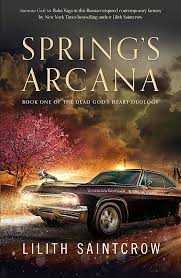Spring’s Arcana by Lilith Saintcrow (Tor, 2023)

Review by Warner Holme: Lilith Saintcrow starts a new series with Spring’s Arcana, the first in what is being called The Dead God’s Heart Duology. With a subject matter and structure that will feel startlingly familiar to fans of contemporary fantasy, this book is going to face some harsh comparisons.
The story largely centers on one Natasha Drozdova. She’s dealing with a crazy life, working low-income in America will do that. On top of this her mother appears to be dying of cancer, making both the emotional and financial concerns all the worse. A distant figure offers some hope if she will come and speak about the matter in Manhattan. Unfortunately once she arrives, Natasha, usually called Nat, finds herself in an increasingly strange to Impossible situation as she quickly realizes the stakes may be higher than she suspected, and as much as she continues to try it is likely her mother is beyond even supernatural help.
It’s a powerful setup, and the use of family hearkens back to a novel this volume will undoubtedly bring many comparisons with. Specifically American Gods by Neil Gaiman has a certain element of road trip amongst mythological and cultural figures as a major element. While the older book has become somewhat legendary, the concept is not exclusive to it and this volume moves at a brisk pace that was decidedly not an element of that one.
Themes of culture, identity, and the adaptation thereof all represent major elements of the story in their own right. However questions of ignorance of one’s heritage are addressed in more detail throughout this book, and the idea of multiple mythologies or even cultural touchstones interacting with one another is used in a much less showy and more careful manner.
The use of primarily Russian folklore and mythology is sensible for a girl who believes herself to be from a Russian American family, and a great deal of thought is put into the way each element appears. While legendary figures known internationally for centuries such as Baba Yaga are given their due in major plot points and set pieces, lesser known figures and those whose prominence has only began to grow in the past few decades in the West like Koschei are given their places as well.
Non-Russian mythological figures are generally used well, either archetypes being touched upon or specific well-known figures. The use of figures like Officer Friendly will baffle those who are both uninformed about the past and outside of certain specific regions, and titling towards another region will only be slightly less so. On the other hand these characters work fine as archetypes, and an added layer of gray is given to the narrative for those who understand the nature of it. While obscure, both work a good sight better than the concept of “media” which was in most ways a cheat when it appeared in the book previously compared, however well used.
Being a part of a duology one does not expect this volume to stand alone, however even this may not prepare readers for the incomplete narrative of the book. Instead it gives a pretty direct look at what stories are involved in the next volume, and what particular challenges Nat will have to face. Given that the story is biomed in large building on folklore, fairy tales, and various National mythologies this is hardly a huge surprise for someone who has kept up with such material. On the other hand it is well executed enough that those familiar will appreciate the atmosphere and those left so will indeed greatly like the telegraphing of potential risks.
While shorter and less sprawling than other books that tell similar stories, it represents a half rather than the entirety of the narrative. For anyone who enjoys a good road trip, quest, and contemporary fantasy it is well worth checking out. It’s a brilliant early novel, and one that should have readers eager for the next book to release.
Discover more from File 770
Subscribe to get the latest posts sent to your email.

Even though it’s urban fantasy, I might read it.
That is, after the second book comes out.
Lilith Saintcrow has a long publication record, with her first novel published in 2004, so it seems a bit odd to see this one described as an “early novel”